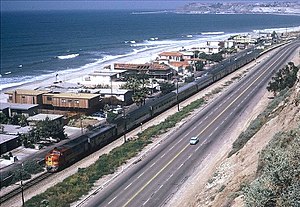 | |
 The southbound San Diegan passes through Capistrano Beach, California in April 1973. | |
| Overview | |
|---|---|
| Service type | Inter-city rail |
| Status | Discontinued |
| Locale | Southern California |
| First service | March 27, 1938 |
| Last service | June 1, 2000 |
| Successor | Pacific Surfliner |
| Former operator(s) | Atchison, Topeka and Santa Fe Railway (1938–1971) Amtrak (1971–2000) |
| Route | |
| Termini | Los Angeles, California San Diego, California |
| Stops | 16 (total) |
| Technical | |
| Track gauge | 4 ft 8+1⁄2 in (1,435 mm) |
| Track owner(s) | ATSF Railway |
The San Diegan was one of the named passenger trains of the Atchison, Topeka and Santa Fe Railway, and a “workhorse” of the railroad. Its 126-mile (203-kilometer) route ran from Los Angeles, California, south to San Diego. It was assigned train Nos. 70–79 (Nos. 80–83 were added in 1952 when RDCs began operating on the line).
The Los Angeles-San Diego corridor was to the Santa Fe what the New York City–Philadelphia corridor was to the Pennsylvania Railroad. Daily traffic could reach a density of ten trains (each way) during the summer months. From the Los Angeles/Orange County border to San Diego, it ran along the Surf Line (officially, the Fourth District of the Los Angeles Division), which was so named because much of its trackage came within fewer than 100 feet of the Pacific Ocean.
The first San Diegan ran on March 27, 1938, as one set of equipment making two round trips a day. A second trainset delivered in 1941 made possible four streamlined trains each way. A set of heavyweight equipment made a fifth trip in each direction. During and after World War II, furlough business from San Diego's military bases necessitated extra (albeit heavyweight) sections of San Diegans, and racetrack specials during horseracing season at Del Mar added to passenger train miles.
Amtrak continued to operate the San Diegan when it took over operation of the nation's passenger service on May 1, 1971. After extending the route to the Central Coast in the 1980s and 1990s, Amtrak rebranded the route as the Pacific Surfliner on June 1, 2000.